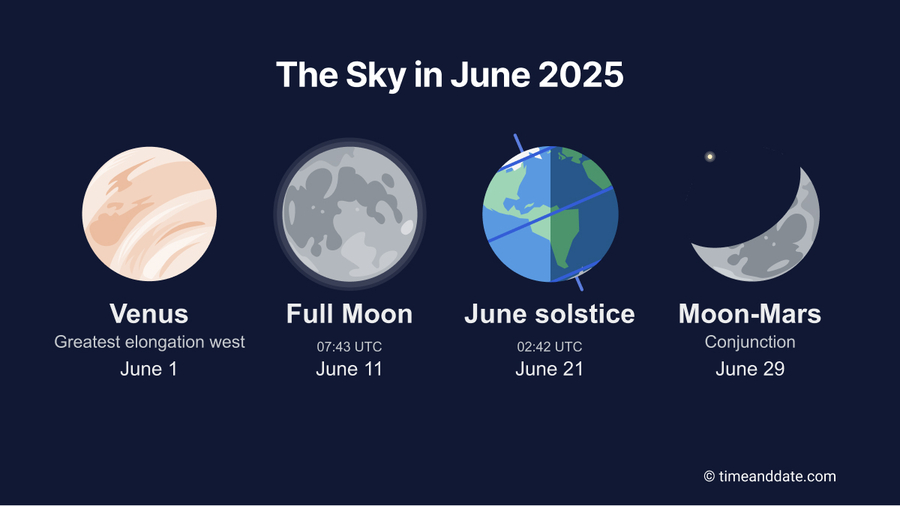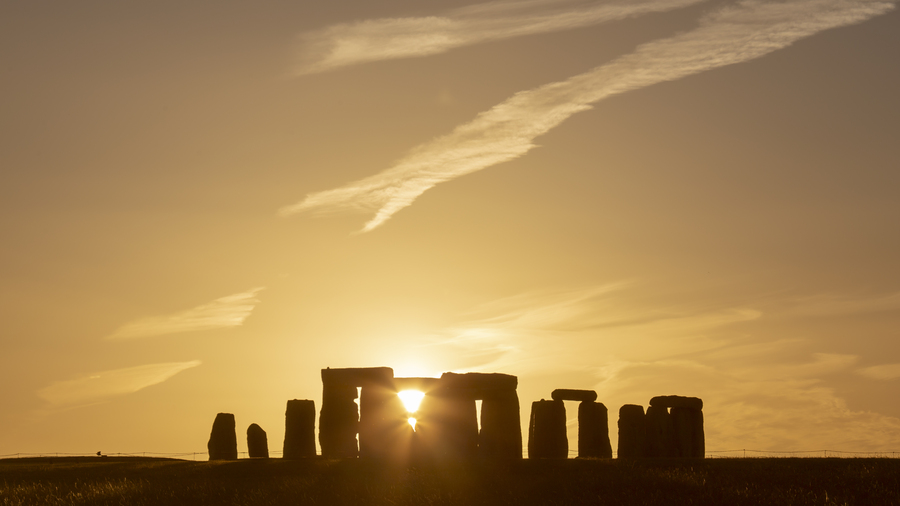
What’s Up in the Sky in June?
June is all about the Sun as we shift seasons on the June solstice. In the Northern Hemisphere, it means more light and the start of summer, and warmer evenings are great for comfortable stargazing.
In the Southern Hemisphere, it’s the winter solstice, which means longer and darker evenings for night sky exploration.
The Northern and Southern Hemispheres| Date | Event* | What to See |
|---|---|---|
| June 1 | Venus at greatest elongation west | Venus is at its farthest distance from the Sun in the sky and shines brightly before sunrise. |
| June 1 | Moon-Mars conjunction | The best time to find Mars close to the Waxing Crescent Moon is just after sunset on the western horizon. |
| June 11 | Full Moon | June’s Strawberry Moon is at its most illuminated at 07:43 UTC. |
| June 19 | Moon-Saturn conjunction | Saturn and the Half Moon are close in the early morning sky. |
| June 22 | Moon-Venus conjunction | A thin Waning Crescent Moon with a very bright Venus. Find the “morning star” just before sunrise on the eastern horizon. |
| June 29–30 | Moon-Mars conjunction | The Waxing Crescent Moon and Mars are very close in the evening sky. |
*Naked-eye events. Night Sky Map links are from New York City, USA.
June Solstice: The Sun Stands Still
On June 21, at exactly 02:42 UTC, the Sun reaches its northernmost point at sunrise and sunset, marking the June solstice.
It is the longest day and shortest night of the year in the Northern Hemisphere. Around this time, the Sun rises and sets at its most northerly points, and moves along its highest path in the sky. Enjoy lingering twilight in northern latitudes during the solstice season.
Sunrise and sunset times for your locationIt’s the opposite in the Southern Hemisphere: June solstice is the shortest day and longest night of the year, with the Sun rising and setting at its most northerly points and moving low in the sky.
Wherever you are on Earth, the solstice is a moment when the Sun appears to stand still on the horizon before it turns and reverses its path.


Defining the Midnight Sun
June is the Midnight Sun season in the northernmost parts of our planet. It is also known as polar day, and although used interchangeably, they have slightly different definitions:
- Polar day: The Sun circles the sky above the horizon without setting, and there is 24-hour daylight.
- Midnight Sun: When the Sun is visible at local midnight. Sometimes used interchangeably with polar day.
The difference comes down to a time period versus a moment in time,
says Renate Mauland-Hus, researcher and astrophysicist at timeanddate.com. In Norway, we use the strict definition of polar day—when the Sun stays above the horizon for all 24 hours and doesn’t set at all, even though we typically call it Midnight Sun.
She adds:
But the term Midnight Sun can also be used for some edge locations that can have Midnight Sun without polar day. In Fairbanks, USA, the Sun is above the horizon at local midnight on the clock, but it dips below the horizon for a short period after.
June Stargazing
The solstice kicks off the astronomical summer season in the Northern Hemisphere night sky, and some constellations and asterisms are well placed in the sky this time of year. Look for the Summer Triangle in the eastern sky, or find the Big Dipper in the constellation Ursa Major.
What are asterisms?A lesser-known constellation, Corona Borealis, is also visible in the summer sky. And if we’re especially lucky, we might see a star known as T Coronae Borealis explode right in the vicinity. (All example links from the Night Sky Map are from New York City, USA.)
What are constellations?In the Southern Hemisphere, it’s winter. Look for the constellation Crux, also known as the Southern Cross, high in the southern sky. You can use the bright stars Alpha Centauri and Beta Centauri, the Southern Pointers, to find your way to Crux in the sky. Interestingly, Alpha Centauri and Beta Centauri are not single stars. They are both star systems, consisting of three stars each,
explains Renate.
The longer and darker winter nights also provide an excellent opportunity to observe our home galaxy—the Milky Way— from a Southern Hemisphere vantage point.
Sky Meets Life: Ancient Solstice Celebrations
The summer solstice in the Northern Hemisphere marks a seasonal turning point. Historically linked to farming, fertility, and the cycles of nature, ancient cultures celebrated summer with feasts, bonfires, and rituals honoring natural forces. These traditions continue today—celebrated with everything from maypole dancing in Sweden to all-night bonfires in the Nordics and Baltics.
June solstice traditionsIn the South American Andes, the traditional Inca celebration, Inti Raymi, is held around the June solstice. It means Festival of the Sun
and marks the winter solstice in the Southern Hemisphere. In ancient times, llamas adorned with silver and gold were sacrificed to honor Inti, the Inca Sun god. Today, the festival includes music, parades, and colorful costumes.


